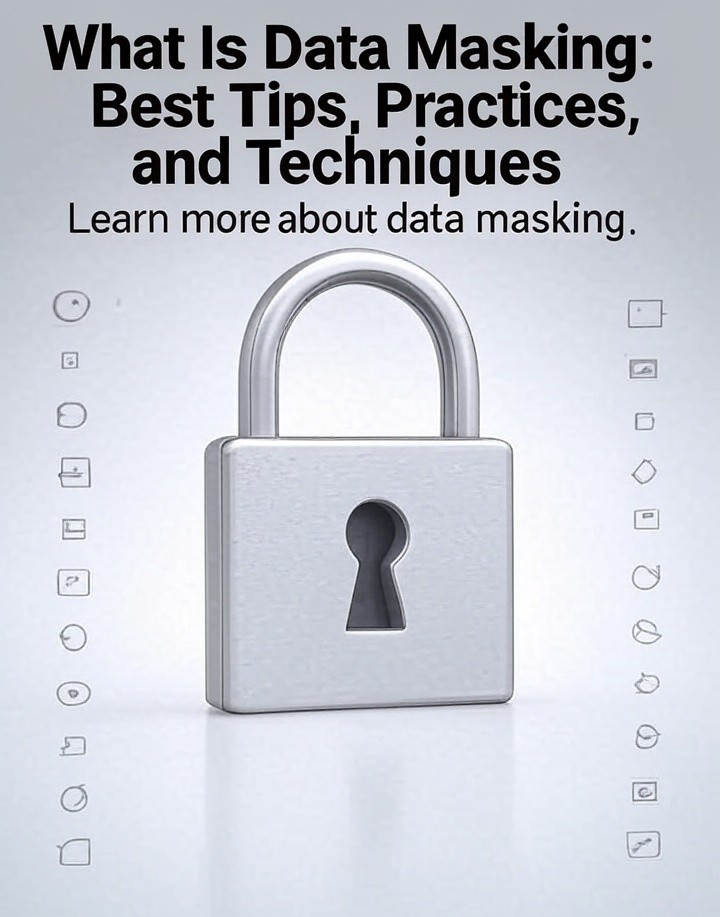
What Is Data Masking? Best Tips, Practices, and Technique
Data masking protects sensitive information—such as personally identifiable information (PII), protected health information (PHI), and payment card data—by replacing real values with realistic substitutes that cannot be reverse-engineered. Unlike encryption, which secures data at rest and in transit but requires keys to decrypt, masked data permanently conceals original values while preserving referential integrity and format, making it ideal for non-production environments.
Why Data Masking Matters
Organizations increasingly face stringent privacy regulations (e.g., GDPR, HIPAA, PCI-DSS) and rising costs of data breaches (averaging $4.88 million in 2024). Data masking:
· Ensures compliance by preventing exposure of sensitive fields in shared or test datasets.
· Enables secure collaboration with third parties by providing realistic data without leaking real information.
· Reduces risk in software development, QA, and analytics by allowing teams to work with lifelike data safely.
Core Data Masking Techniques
1. Static Data Masking
Creates a permanently masked copy of a production database for use in non-production environments.
2. Dynamic Data Masking
Applies masking rules at query time, altering results for non-privileged users while leaving the source data unchanged.
3. On-the-Fly Masking
Transforms sensitive data during transfer between environments, ideal for continuous integration and migrations.
Eight Common Masking Methods
-
Pseudonymization
- Replaces identifiers (e.g., names, emails) with consistent aliases; reversible if mapping tables are retained.
-
Anonymization
- Irreversibly encodes identifiers to eliminate linkage to real individuals, preserving statistical utility.
-
Lookup Substitution
- Uses a lookup table to swap original values with safe alternatives, retaining realism and consistency.
-
Encryption
- Encrypts data so only holders of decryption keys can view original values; often combined with other masking methods for robust protection.
-
Redaction
- Removes or blanks out sensitive fields entirely when they aren’t needed for downstream processes.
-
Averaging
- Replaces individual values with aggregate averages to hide outliers while preserving overall statistics (e.g., salaries).
-
Shuffling
- Randomly reassigns real values among records, preserving distribution but unlinking values from original records.
-
Date Switching
- Applies a uniform shift to date fields (e.g., subtracting 30 days) to obfuscate actual timelines while retaining relative ordering.
Best Practices for Effective Data Masking
1. Comprehensive Data Discovery and Classification
Begin by inventorying all data stores and identifying fields that contain PII, PHI, IP, or financial data using automated discovery tools and metadata analysis.
2. Define Clear Masking Policies
Establish a masking policy matrix mapping data categories to appropriate techniques (e.g., email fields→partial masking; SSNs→random or lookup substitution).
3. Preserve Referential and Semantic Integrity
Ensure that masked keys remain consistent across related tables and that generated values respect data types, formats, and business rules (e.g., valid date ranges, gender-consistent names).
4. Role-Based Access and Auditing
Restrict UNMASK or key retrieval capabilities to authorized roles and audit all masking/unmasking operations to detect misuse.
5. Iterative Testing and Validation
Validate masked datasets against use-case requirements, verifying that applications, reports, and analytics yield expected results without exposing real data.
6. Automation and Scalability
Leverage masking tools that integrate with CI/CD pipelines and orchestrate masking across multiple environments in a consistent, repeatable manner.
7. Ongoing Review and Maintenance
Regularly review masking rules as schemas evolve, new data sources are added, or regulatory requirements change.
Conclusion
Data masking is a foundational component of data security and compliance strategies, enabling organizations to share and utilize lifelike data without risking sensitive information. By understanding core techniques, adhering to best practices, and choosing tools that enforce referential integrity and automation, businesses can safeguard customer trust, achieve regulatory compliance, and accelerate innovation in development and analytics.






